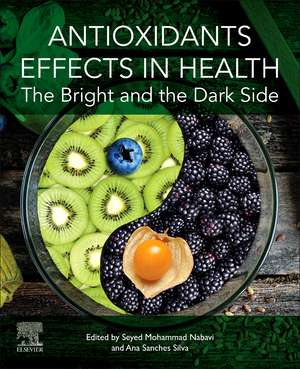Antioxidants Effects in Health: The Bright and the Dark Side
Editat de Seyed Mohammad Nabavi, Ana Teresa Sanches Silvaen Limba Engleză Paperback – 22 iun 2022
- Introduces recent information on antioxidants in a systematic way
- Provides an overview of the history and function of antioxidants
- Contains discussion of antioxidants including their chemistry, sources and main effects
Preț: 744.48 lei
Preț vechi: 916.46 lei
-19% Nou
Puncte Express: 1117
Preț estimativ în valută:
142.45€ • 149.13$ • 117.87£
142.45€ • 149.13$ • 117.87£
Carte tipărită la comandă
Livrare economică 29 martie-12 aprilie
Livrare express 04-08 martie pentru 217.08 lei
Preluare comenzi: 021 569.72.76
Specificații
ISBN-13: 9780128190968
ISBN-10: 0128190965
Pagini: 912
Ilustrații: 50 illustrations (10 in full color)
Dimensiuni: 191 x 235 x 52 mm
Greutate: 1.82 kg
Editura: ELSEVIER SCIENCE
ISBN-10: 0128190965
Pagini: 912
Ilustrații: 50 illustrations (10 in full color)
Dimensiuni: 191 x 235 x 52 mm
Greutate: 1.82 kg
Editura: ELSEVIER SCIENCE
Cuprins
Part 1. Introduction
1. Evolution of antioxidants over times
2. The oxidative stress: Causes, free radicals, targets, mechanisms, affected organs, effects, indicators
3. Food autooxidation
Part 2. Endogenous antioxidants
4. Alpha lipoic acid
5. Bilirubin
6. Catalase
7. Coenzyme Q
8. Ferritin
9. Glucose-6-phosphate-dehydrogenase
10. Glutathione peroxidise
11. Glutathione reductase
12. Gluthathione
13. Superoxide dismutase
14. Uric acid
Part 3. Synthetic antioxidants: bright and the dark side
15. Ascorbyl palmitate
16. Butylated hydroxyanisole (BHA)
17. Butylated hydroxytoluene (BHT)
18. Erythorbic acid (D-ascorbic acid)
19. Nordihydroguaiaretic acid (NDGA)
20. Octyl gallate (OG)
21. Propyl gallate (PG)
22. tert-butylhydroxyquinone (TBHQ)
Part 4. Natural occurring antioxidants: bright and the dark side
23. Amino acids
24. Carnosine
25. Carnosol
26. Carotenoids (xanthophylls and carotenes)
27. Citric acid
28. Coenzyme Q
29. Curcumin
30. Flavonoids
31. Lecithin
32. Lignans
33. Organosulfur compounds( allyl sulphide, indoles)
34. Phenolic acids
35. Phytic acid
36. Protein hydrolysates
37. Saponins
38. Selenium
39. Sterols
40. Stilbenes
41. Tartaric acid
42. Turmeric
43. Uric acid
44. Vanillin
45. Vitamin A (retinol)
46. Vitamin C
47. Vitamin E (tocopherols and tocotrienols)
48. Vitamin K
49. Zinc
Part 5. Antioxidants and diseases: Beneficial and detrimental effects
50. Antioxidants and cancer
51. Antioxidants and cardiovascular diseases
52. Antioxidants and cataracts/ age-related macular degeneration
53. Antioxidants and cognitive decline in elderly
54. Antioxidants and dentistry
55. Antioxidants and diabetes
56. Antioxidants and gastric lesions
57. Antioxidants and immune functions
58. Antioxidants and infertility
59. Antioxidants and liver diseases
60. Antioxidants and neurological disorders and psychiatric disorders
61. Antioxidants and respiratory diseases
62. Antioxidants and viral diseases
Part 6: Actual and future perspectives on antioxidants
63. Duality: antioxidants/prooxidants
64. Food and food supplements antioxidants: Targets in human antioxidant system and effects on the production of endogenous antioxidants
65. Concluding remarks and future perspectives
1. Evolution of antioxidants over times
2. The oxidative stress: Causes, free radicals, targets, mechanisms, affected organs, effects, indicators
3. Food autooxidation
Part 2. Endogenous antioxidants
4. Alpha lipoic acid
5. Bilirubin
6. Catalase
7. Coenzyme Q
8. Ferritin
9. Glucose-6-phosphate-dehydrogenase
10. Glutathione peroxidise
11. Glutathione reductase
12. Gluthathione
13. Superoxide dismutase
14. Uric acid
Part 3. Synthetic antioxidants: bright and the dark side
15. Ascorbyl palmitate
16. Butylated hydroxyanisole (BHA)
17. Butylated hydroxytoluene (BHT)
18. Erythorbic acid (D-ascorbic acid)
19. Nordihydroguaiaretic acid (NDGA)
20. Octyl gallate (OG)
21. Propyl gallate (PG)
22. tert-butylhydroxyquinone (TBHQ)
Part 4. Natural occurring antioxidants: bright and the dark side
23. Amino acids
24. Carnosine
25. Carnosol
26. Carotenoids (xanthophylls and carotenes)
27. Citric acid
28. Coenzyme Q
29. Curcumin
30. Flavonoids
31. Lecithin
32. Lignans
33. Organosulfur compounds( allyl sulphide, indoles)
34. Phenolic acids
35. Phytic acid
36. Protein hydrolysates
37. Saponins
38. Selenium
39. Sterols
40. Stilbenes
41. Tartaric acid
42. Turmeric
43. Uric acid
44. Vanillin
45. Vitamin A (retinol)
46. Vitamin C
47. Vitamin E (tocopherols and tocotrienols)
48. Vitamin K
49. Zinc
Part 5. Antioxidants and diseases: Beneficial and detrimental effects
50. Antioxidants and cancer
51. Antioxidants and cardiovascular diseases
52. Antioxidants and cataracts/ age-related macular degeneration
53. Antioxidants and cognitive decline in elderly
54. Antioxidants and dentistry
55. Antioxidants and diabetes
56. Antioxidants and gastric lesions
57. Antioxidants and immune functions
58. Antioxidants and infertility
59. Antioxidants and liver diseases
60. Antioxidants and neurological disorders and psychiatric disorders
61. Antioxidants and respiratory diseases
62. Antioxidants and viral diseases
Part 6: Actual and future perspectives on antioxidants
63. Duality: antioxidants/prooxidants
64. Food and food supplements antioxidants: Targets in human antioxidant system and effects on the production of endogenous antioxidants
65. Concluding remarks and future perspectives
